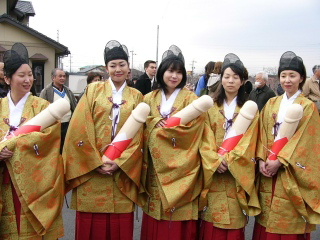 |
| Bell of Tagata Jinja (this and following two photos from yamasa.org) |
Address: 152, Tagata-cho, Komaki City, Aichi 485-0004
Tel/Information: 0568-76-2906 Pamphlet in English available for 100 yen.
How to get there: Take the Inuyama line from Meitetsu Shin Nagoya Station to Inuyama Station. Transfer to the Komaki Line and take the train to Tagata Jinja-mae Station, then a few minutes by foot.
Enshrined kami: Tamahime no mikoto, Mitoshi no kami
Prayers offered: Successful childbirth, anything related to fertility and growth.
Best time to go: Best to go for the Hounen Matsuri in March.
While you're here, any readers who are interested in having a kamidana of their own, or would like to send one to a friend or family member, please check out this post: https://shintoshrinesofjapanblogguide.blogspot.com/2019/06/portable-kamidana-jinja.html
While you're here, any readers who are interested in having a kamidana of their own, or would like to send one to a friend or family member, please check out this post: https://shintoshrinesofjapanblogguide.blogspot.com/2019/06/portable-kamidana-jinja.html
Important physical features: The smallish grounds and the buildings of Tagata Jinja are of less interest than what lies within and around the buildings. Yet it is these objects of veneration that attract worshipers, visitors and gawkers from around Japan and around the world. Simply put, it is the penis, in every shape and size, in both wood and stone, that attracts so much attention. The grand daddy of them all is the 7-foot, 600-pound O-owasegata carved afresh each year from a cedar log, and used in the shrine's famous Hounen-sai festival. Enshrined afresh each year it will be unceremoniously sold off and replaced with a new one when its time is up.
 |
| O-owasegata in procession |
 |
| O-owasegata enshrined |
This is not to say that the other half of the equation has been totally neglected. There are a number of vaginas in evidence and especially among the various mementos (omiage) offered during festivals. But the female role is left, for the most part, to a sort of sister shrine (poor choice of words perhaps) called Oagata Jinja in the nearby town of Inuyama. Here, the female image is ascendant and the Honen-sai is held on the weekend before that of Tagata. At Oagata one can find the hime ishi (princess stone) in the shape of the vagina. This kind of yin/yang (in/yo in Japanese), male/female imagery is fully accepted for what it is, a mildly titillating prayer for fecundity and good health. To some degree it represents the dichotomy of feeling natural and comfortable with sexuality, while at the same time trying to elevate such images to the realm of the divine. Another take on this dichotomy is offered by scholar Allan Grapard who postulates that women in Japan were relegated to the level of biological production while men were producers of culture. In displays of phallic imagery within the context of the sacred, one sees the perpetual search for accommodation between the “higher” and “baser” self.
In Hindu religion, the lingam (male) and the yoni (female) play a similar role as fertility symbols as well as symbols of human sexuality and of the positive and protective powers of the gods. Here too, the symbolism varies from the hidden and subtle to the overt and extrovert. In India as in Japan there is no moral indignation at the use of these symbols—though there may be some embarrassment. In Japan, embarrassment comes with self-consciousness and self-consciousness became greater with exposure to foreign culture. Thus, with the full-scale entry of the West into Japan during the Meiji era, the authorities became self-conscious of this aspect of native culture and did their best to suppress overt sexual images, especially as regards the Dosojin images that populated the countryside. Today, official condemnation is gone but the personal sense of embarrassment (and joy at the embarrassment of others) is just one more important aspect of the celebration at Tagata Jinja and its famous phallic festival!
 |
| Maidens of the Hounen-sai (photo from kikuko-nagoya.com) |
Ooagata Jinja
 |
| Honden of Ooagata Jinja (photo by Yuta Yanagida via Google +) |
Address: 3 Aza-Miyayama, Inuyama City, Aichi 485-0004
Tel/Information: 0568-67-1017
How to get there: Take the Meitetsu Komaki line to Gakuden station and walk about 10 minutes.
Enshrined kami: Ooagata okami
Description: The long approach road rises gradually as you near the stone torii of Ooagata Jinja. The honden was built in the Owari zukuri style in 1661 and is designated an Important Cultural Property. The shrine is located in the foothills east of Nagoya in a lovely setting rich in Japanese apricot (ume) trees. There are several shrines on the grounds, the main one dedicated to Oagata omikami. Other sub shrines are dedicated to Tamahime no mikoto (the same kami as enshrined in Tagata Jinja) and Ebisu. This shrine is considered a pair with Tagata Jinja and they share the same festival, the Honen-sai, with Ooagata holding theirs one week before Tagata. Ooagata is considered the female counterpart and several large stones in the shape of a vagina are venerated.
You handled that with delicacy. =D Nice job.
ReplyDeleteGlad to have found your blog, after our brief conversation on Amazon regarding Shinto Shrines (which I'm leaning over to type this.) Gearing up for this year's trip, catching up on reading, and happy to see you on the web.
Hey Pattie,
DeleteThanks for remembering (I think you first asked about a shrine book back in 2010?) and thanks for your support. So, you are getting a chance to come to Japan? If I can be of any help with information, please let me (or others) know through the ShintoML.
Cheers!